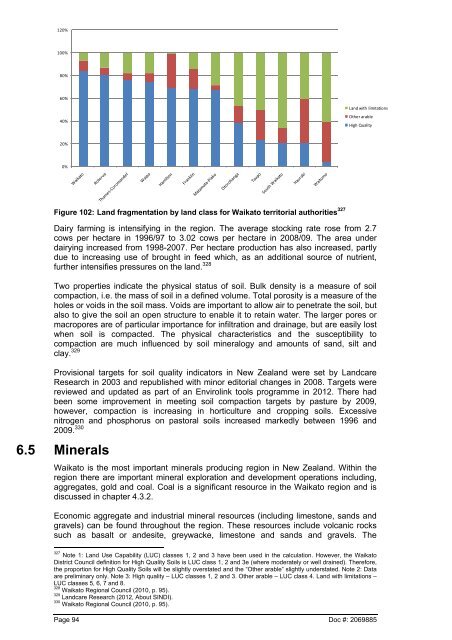Waikato regional economic profile - Waikato Regional Council
Waikato regional economic profile - Waikato Regional Council
Waikato regional economic profile - Waikato Regional Council
- No tags were found...
Create successful ePaper yourself
Turn your PDF publications into a flip-book with our unique Google optimized e-Paper software.
120%100%80%60%40%Land with limitationsOther arableHigh Quality20%0%Figure 102: Land fragmentation by land class for <strong>Waikato</strong> territorial authorities 327Dairy farming is intensifying in the region. The average stocking rate rose from 2.7cows per hectare in 1996/97 to 3.02 cows per hectare in 2008/09. The area underdairying increased from 1998-2007. Per hectare production has also increased, partlydue to increasing use of brought in feed which, as an additional source of nutrient,further intensifies pressures on the land. 328Two properties indicate the physical status of soil. Bulk density is a measure of soilcompaction, i.e. the mass of soil in a defined volume. Total porosity is a measure of theholes or voids in the soil mass. Voids are important to allow air to penetrate the soil, butalso to give the soil an open structure to enable it to retain water. The larger pores ormacropores are of particular importance for infiltration and drainage, but are easily lostwhen soil is compacted. The physical characteristics and the susceptibility tocompaction are much influenced by soil mineralogy and amounts of sand, silt andclay. 329Provisional targets for soil quality indicators in New Zealand were set by LandcareResearch in 2003 and republished with minor editorial changes in 2008. Targets werereviewed and updated as part of an Envirolink tools programme in 2012. There hadbeen some improvement in meeting soil compaction targets by pasture by 2009,however, compaction is increasing in horticulture and cropping soils. Excessivenitrogen and phosphorus on pastoral soils increased markedly between 1996 and2009. 3306.5 Minerals<strong>Waikato</strong> is the most important minerals producing region in New Zealand. Within theregion there are important mineral exploration and development operations including,aggregates, gold and coal. Coal is a significant resource in the <strong>Waikato</strong> region and isdiscussed in chapter 4.3.2.Economic aggregate and industrial mineral resources (including limestone, sands andgravels) can be found throughout the region. These resources include volcanic rockssuch as basalt or andesite, greywacke, limestone and sands and gravels. The327Note 1: Land Use Capability (LUC) classes 1, 2 and 3 have been used in the calculation. However, the <strong>Waikato</strong>District <strong>Council</strong> definition for High Quality Soils is LUC class 1, 2 and 3e (where moderately or well drained). Therefore,the proportion for High Quality Soils will be slightly overstated and the “Other arable” slightly understated. Note 2: Dataare preliminary only. Note 3: High quality – LUC classes 1, 2 and 3. Other arable – LUC class 4. Land with limitations –LUC classes 5, 6, 7 and 8.328<strong>Waikato</strong> <strong>Regional</strong> <strong>Council</strong> (2010, p. 95).329Landcare Research (2012, About SINDI).330<strong>Waikato</strong> <strong>Regional</strong> <strong>Council</strong> (2010, p. 95).Page 94 Doc #: 2069885
















